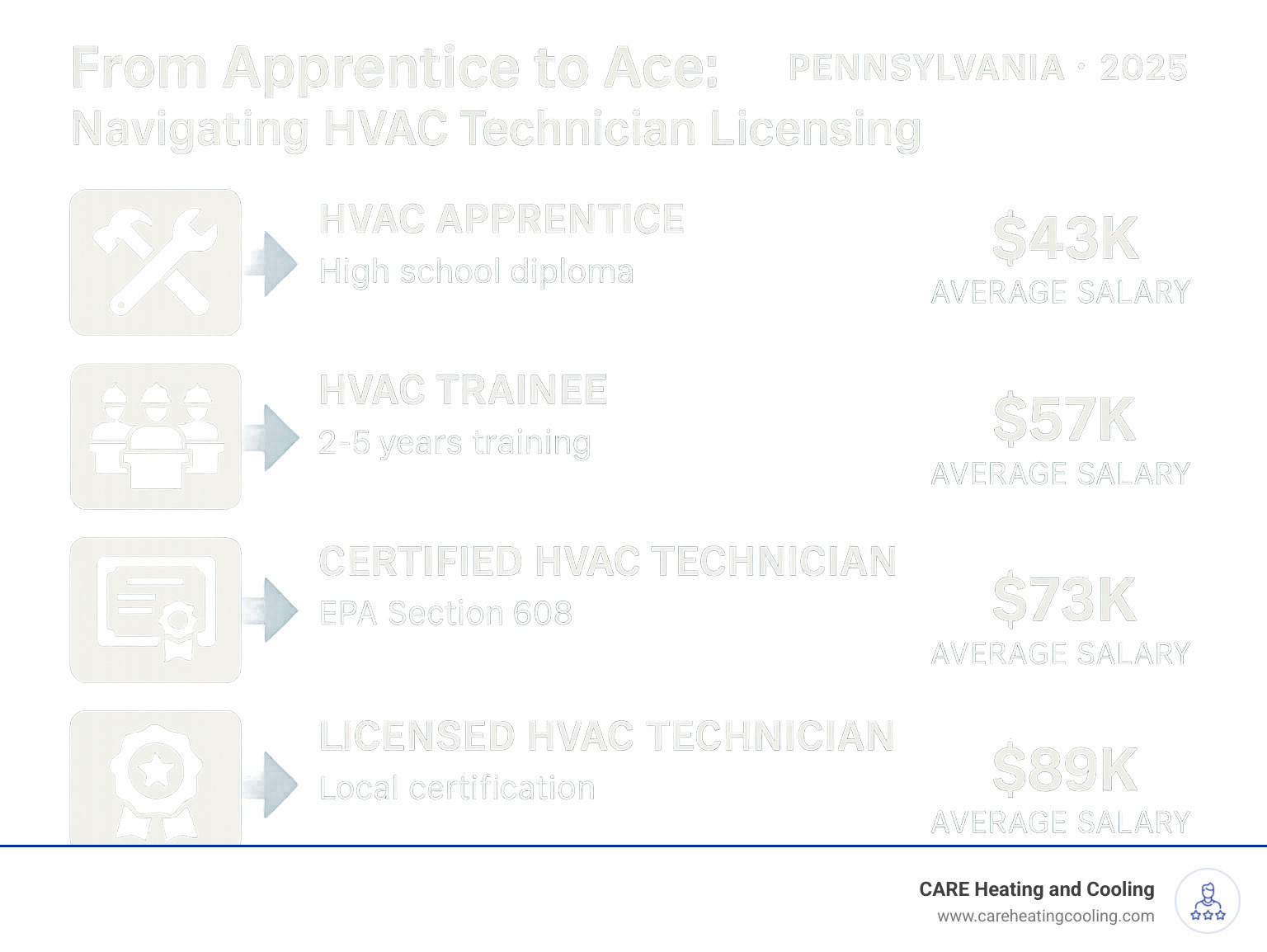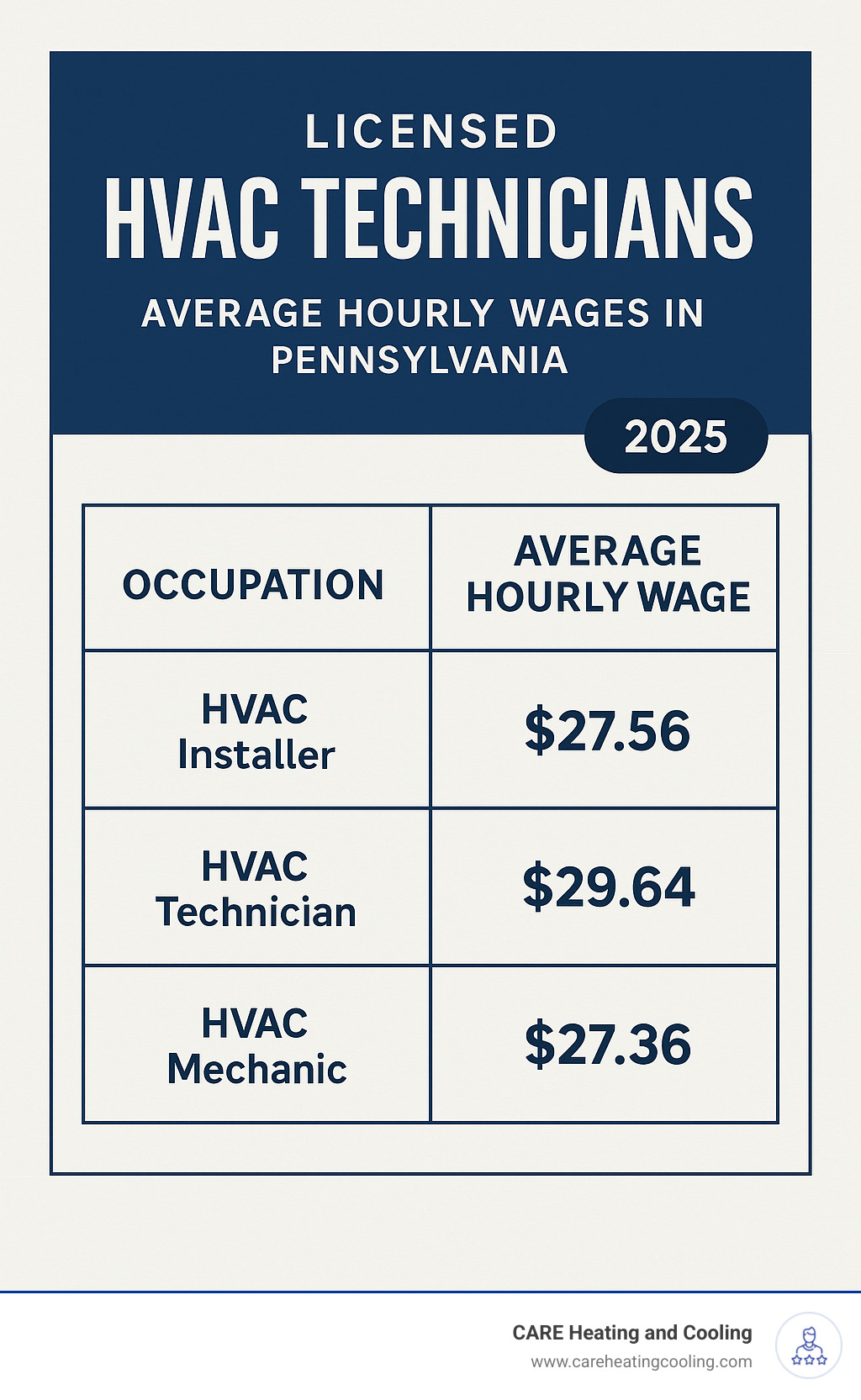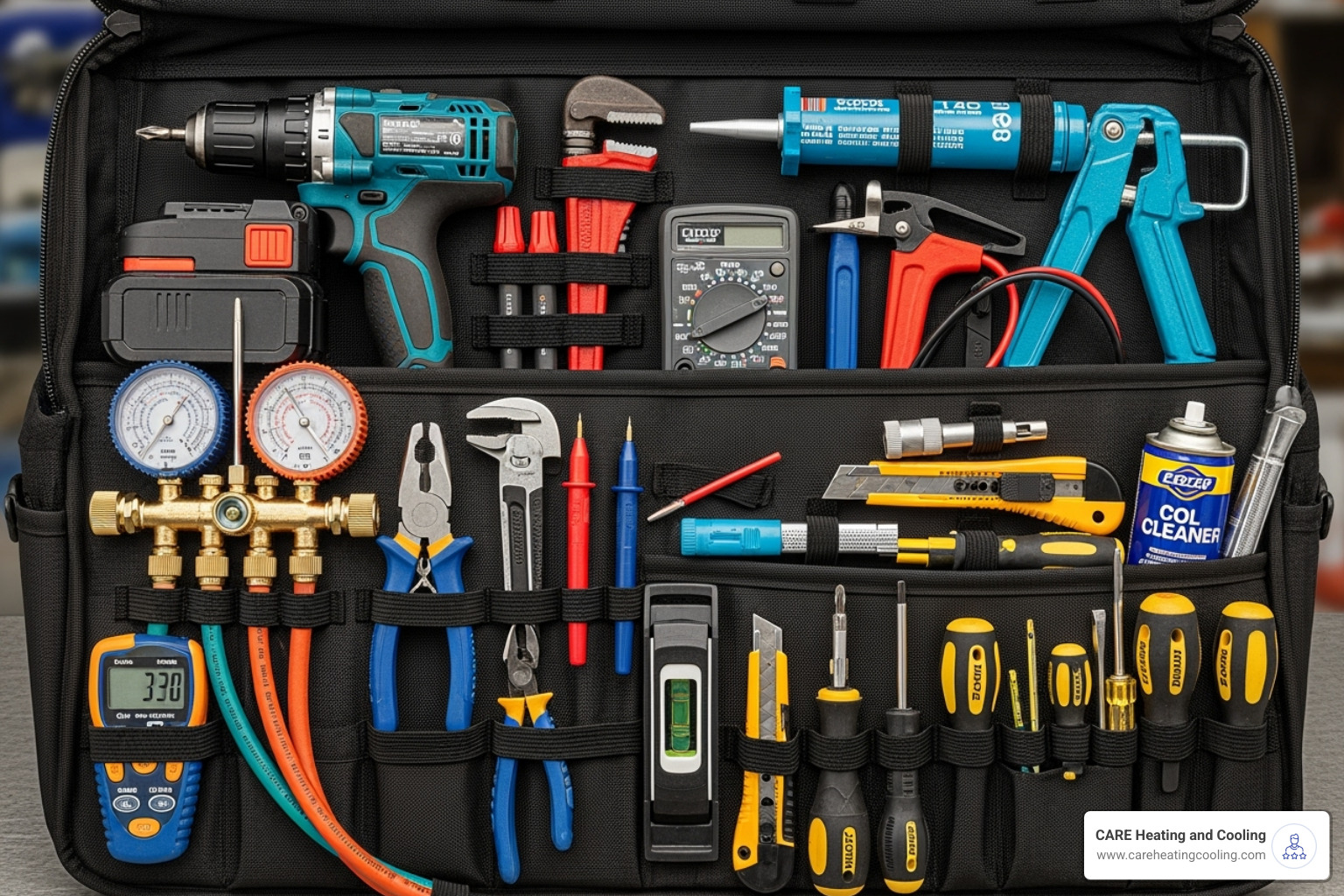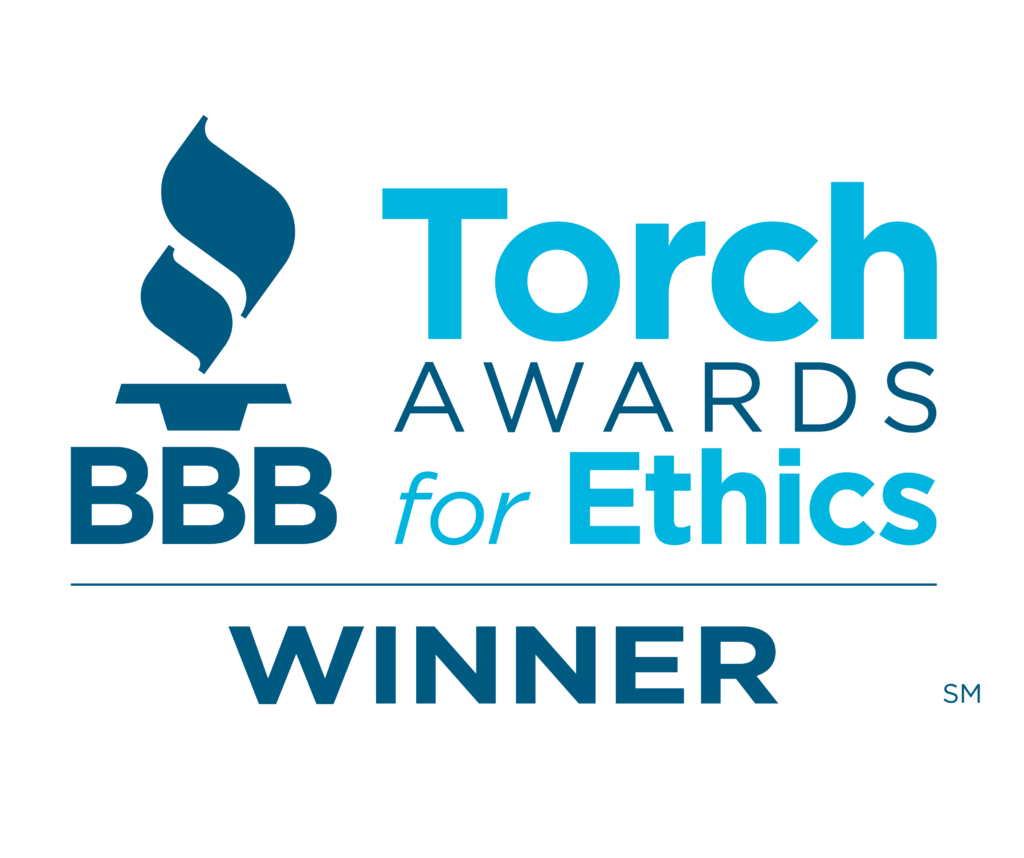Why Licensed HVAC Technicians Matter for Ohio Homeowners
Licensed HVAC technicians are certified professionals who have completed formal training, passed required examinations, and meet state and federal standards to safely install, maintain, and repair heating, ventilation, and air conditioning systems. In Ohio, commercial contractors must hold a state-level license from the Ohio Construction Industry Licensing Board (OCILB), while all technicians handling refrigerants need federal EPA certification.
Key Requirements for Licensed HVAC Technicians in Ohio:
- State-Level OCILB License – mandatory for commercial contractors
- Federal EPA Section 608 Certification – mandatory for refrigerant handling
- Local registration – may be required by certain municipalities
- Proper insurance coverage – general liability is required for state licensure
- Continuing education – necessary to maintain state licenses and stay current
Ohio is a major hub for the skilled trades, ranking as one of the top five employers of HVAC technicians in the country with over 15,800 professionals. The average HVAC technician salary in Ohio is approximately $58,000 annually, with experienced supervisors earning significantly more.
The path from apprentice to licensed professional typically takes 3-5 years, combining classroom instruction with hands-on experience. For homeowners, working with licensed technicians ensures that work is performed safely, meets state and local codes, and is backed by the proper insurance and expertise.
Why Pursue an HVAC License in Ohio?
If you’re considering a career in the skilled trades, becoming a licensed HVAC technician in Ohio is a fantastic choice. The demand for heating, ventilation, air conditioning, and refrigeration (HVAC/R) professionals is consistently high, offering job security, clear paths for career advancement, and impressive earning potential. This is a vital role in keeping homes and businesses comfortable and safe.
Ohio is a hotbed for HVAC opportunities, proudly standing as one of the top five highest employers of HVAC technicians nationwide. With over 15,800 professionals already working in the state, our industry is robust and growing. The U.S. Bureau of Labor Statistics projects a healthy 9% growth for HVAC technicians from 2023 to 2033. This demand is real—a staggering 93% of firms in the United States recently reported unfilled hourly craft positions, highlighting the urgent need for qualified individuals.
Beyond job security, the financial rewards are significant. The average HVAC technician salary in Ohio is around $58,000 annually, or about $27.93 per hour. As you gain experience and take on more responsibility, your earning potential skyrockets. Experienced HVAC Supervisors can command an average base pay well over $80,000 per year. This isn’t just a job; it’s a career with a clear upward trajectory.
The typical job duties of a licensed HVAC technician in Ohio are as varied as the weather in the Buckeye State. You’ll be involved in installing, maintaining, and repairing heating, ventilation, cooling, and refrigeration systems. This means everything from troubleshooting complex electrical systems to ensuring proper airflow and optimizing energy efficiency in residential homes, commercial buildings, schools, and hospitals. It’s a hands-on role that requires technical expertise, problem-solving skills, and a commitment to customer service.
The Career Trajectory for Licensed HVAC technicians
The journey to becoming a fully licensed HVAC technician is a structured and rewarding one. It often begins with an apprenticeship, where you “earn while you learn” under the supervision of experienced, certified technicians. This foundational stage is crucial for developing practical skills.
From there, many progress to a Journeyman role, which signifies a higher level of competence and independence. The pinnacle for many is becoming a Master technician or obtaining a contractor’s license, denoting extensive experience and the ability to manage complex projects and even run a business.
Beyond these traditional roles, specialization paths abound, such as commercial refrigeration, geothermal systems, or smart home HVAC integration. Each step up the ladder increases your marketability and earning potential. For us, the benefits of licensing extend beyond personal career growth. It significantly increases customer trust and improves our professional credibility. When we arrive as licensed HVAC technicians, customers know they’re dealing with qualified experts who adhere to the highest industry standards.
Salary and Job Outlook in the Buckeye State
The HVAC industry in Ohio offers competitive wages, and the demand ensures a bright future for those entering the field.
| Role | Average Hourly Wage in Ohio |
|---|---|
| HVAC Installer | $26.50 |
| HVAC Technician | $27.93 |
| HVAC Mechanic | $27.15 |
These are just averages, of course. Your actual earnings can be influenced by your experience, specific certifications, and where you work within the state. The job outlook remains incredibly strong. Employment for HVAC technicians is predicted to grow by 9% nationwide from 2023 to 2033. This consistent growth, coupled with the ongoing shortage of skilled labor, means that qualified HVAC professionals are in high demand and can often command excellent opportunities and overtime potential.
Understanding HVAC Licenses and Certifications
Unlike some states with complex local rules, Ohio has a more streamlined approach. The state requires commercial HVAC contractors to obtain a license from the Ohio Construction Industry Licensing Board (OCILB). This single, statewide license ensures a consistent standard of quality and safety for commercial projects across Ohio.
While the state license is for commercial work, technicians working on residential systems must still meet local municipal requirements and, most importantly, hold federal certifications for handling refrigerants. The OCILB license is the primary credential for any HVAC professional looking to advance their career to the contractor level.
To qualify for an OCILB license, an applicant must be at least 18 years old, be a US citizen or legal resident, and have at least five years of relevant experience. You must also pass a state-approved exam and carry a minimum of $500,000 in contractor liability insurance. Renewal requirements for the OCILB license include completing continuing education hours, ensuring that licensed professionals stay up-to-date on the latest codes, technologies, and safety practices.
Federal Mandate: The EPA Section 608 Certification
No matter where you work in Ohio or the rest of the country, one certification is absolutely essential for any licensed HVAC technician who handles refrigerants: the EPA Section 608 certification. This is a federal requirement under the Clean Air Act.
Refrigerants can harm the environment if released, so this certification ensures that technicians know how to handle, recover, and dispose of them safely and responsibly. The certification comes in four types:
- Type I: For small appliances (e.g., window ACs).
- Type II: For high-pressure systems (e.g., residential ACs).
- Type III: For low-pressure systems (e.g., commercial chillers).
Most aspiring technicians aim for the Universal certification, which covers all three types and offers the most career flexibility. Without this certification, you cannot legally work with refrigerants, a fundamental part of most HVAC jobs.
Industry-Standard Certifications to Boost Your Career
While the EPA certification is required, several other industry-recognized certifications can make your resume shine and demonstrate a higher level of expertise.
The NATE certification (North American Technician Excellence) is widely considered the gold standard in our industry. It offers specialty certifications in areas like air conditioning, heat pumps, and gas heating, signaling to customers that you are a top-tier professional.
Other valuable credentials include:
- ASHRAE certifications: Ideal for those interested in commercial projects and building energy efficiency.
- RSES certifications: Offered by the Refrigeration Service Engineers Society, these cover a broad spectrum of HVAC/R topics.
- BPI certifications: The Building Performance Institute offers certifications focused on whole-house energy efficiency.
These certifications aren’t always legally required, but they are powerful tools for career advancement, opening doors to specialized, higher-paying positions and building tremendous trust with clients.
Your Step-by-Step Guide to Becoming a Licensed HVAC Technician
Ready to start a rewarding career as a licensed HVAC technician? The path ahead is clear and achievable, though it requires dedication and hard work. Before you begin, you’ll need to be at least 18 years old and have your high school diploma or GED. The work is physical, involving lifting, working in tight spaces, and enduring various weather conditions. If you enjoy hands-on problem-solving, you’re on the right track!
Step 1: Get the Right Education and Training
Your journey begins with a solid educational foundation. Ohio offers fantastic HVAC training options, from community colleges to specialized technical schools. Certificate programs can be completed in as little as 6-12 months, while associate degree programs typically take 2 years and provide a broader knowledge base.
Ohio has some excellent schools to choose from, including Columbus State Community College, Sinclair Community College, and Ohio Technical College. Your coursework will cover HVAC system design, gas and electric heating, refrigeration theory, and troubleshooting. You’ll also study Ohio HVAC codes to ensure all your work is safe and compliant.
Step 2: Gain Hands-On Experience Through an Apprenticeship
Apprenticeships are where you earn while you learn, applying classroom knowledge in the real world. You’ll work alongside experienced licensed HVAC technicians who will serve as your mentors. Most apprenticeships last between 3 to 5 years and are the primary way to gain the experience needed for state licensure.
To find an apprenticeship, contact local HVAC contractors, unions, and trade associations like the Air Conditioning Contractors of Ohio (ACCO). An apprenticeship provides a structured path to becoming a skilled technician, and you’ll earn a paycheck with benefits the entire time.
Step 3: Pass Your Certification and Licensing Exams
This is where you prove your expertise. The EPA Section 608 Certification is a mandatory federal exam for handling refrigerants. Once you pass it, you’re certified nationwide.
For those pursuing a commercial contractor license in Ohio, you’ll need to pass the state-level OCILB exam, which is administered by a third-party testing company. These exams typically cost around $150 and require a score of at least 70% to pass. Your education and apprenticeship will prepare you for this, but dedicated study is key.
Smart preparation is your secret weapon. Gather study materials like textbooks and online practice tests. Create a study schedule and focus on your weaker areas. Joining a study group can also be very effective. These exams exist to ensure you can protect public comfort and safety, a responsibility worth taking seriously.
Step 4: Gather Your Essential Tools
Every craftsperson needs their tools, and as a licensed HVAC technician, you’ll build a professional toolkit that becomes an extension of your skills.
- Hand Tools: You’ll need a quality set of screwdrivers, pliers, adjustable wrenches, pipe cutters, and wire strippers.
- Testing Equipment: A multimeter for electrical tests, a manifold gauge set for refrigeration work, and digital thermometers are essential for accurate diagnostics.
- Safety Equipment: This is non-negotiable. Always use your Personal Protective Equipment (PPE), including safety glasses, work gloves, and steel-toed boots.
- Refrigerant Equipment: To comply with your EPA certification, you’ll need a recovery/recycling unit, recovery cylinders, and a precise refrigerant scale.
Building your toolkit is an investment in your future. Start with the essentials and add specialized equipment as your career grows.
Frequently Asked Questions about HVAC Licensing
Figuring out the path to becoming a licensed HVAC technician can bring up a lot of questions. Here are straight answers to some of the most common ones we hear.
How long does it take to become a licensed HVAC technician in Ohio?
There’s no single timeline, but a typical path involves a few key stages. First, a training program can take anywhere from 6 months for a certificate to 2 years for an associate degree. After that, you’ll enter an apprenticeship or gain on-the-job experience, which typically takes 3 to 5 years to accumulate the hours needed for licensure.
Your EPA Section 608 certification can be earned relatively quickly with focused study. When you add it all up, most people are looking at 3 to 5 years from the start of their training to becoming an experienced, licensed professional. You’re earning a wage for most of this journey.
Does an HVAC license from Ohio have reciprocity in other states?
Yes, this is a significant benefit of Ohio’s state-level licensing system. The Ohio Construction Industry Licensing Board (OCILB) has reciprocity agreements with several other states, including Kentucky, West Virginia, and South Carolina. This means that if you hold an Ohio HVAC contractor license, you may be able to obtain a license in those states through a streamlined process without having to take their exam.
This makes an Ohio license more portable than licenses from states without such agreements. Your EPA Section 608 certification is also federal, so it’s recognized everywhere in the U.S. Your experience and other industry certifications like NATE are also highly valued nationwide.
What are the main costs associated with getting licensed?
Planning for the costs is a smart step. The expenses can vary depending on the path you choose.
- Training Programs: This is often the largest upfront cost, with trade school and community college programs running several thousand dollars. However, apprenticeships often have little to no tuition cost.
- Exam Fees: The EPA Section 608 exam can cost from $20 to $150. The Ohio OCILB contractor exam fee is typically around $130-$150.
- Licensing and Renewal: The initial application for an OCILB license has a fee, and it must be renewed periodically, which also includes a fee and the cost of continuing education courses.
- Tools: A quality starter set of tools can be a significant investment, but it’s essential for your career.
While there are costs involved, the return on investment is impressive. With the average licensed HVAC technician in Ohio earning over $58,000 annually, these costs are quickly recovered.
Advance Your Career with the Right Team
Congratulations! You’ve made it through our comprehensive guide to becoming a licensed HVAC technician in Ohio. By now, you understand that this journey is about much more than just passing exams. You’re entering a profession that truly matters—one where your skills keep families comfortable, businesses running, and communities thriving.
The path to becoming a licensed HVAC technician requires dedication, continuous learning, and a commitment to excellence. But the technical skills are only part of what makes a great technician. The other part? Ethics and integrity. When you show up at someone’s home, they’re trusting you with their comfort and safety.
This is why we’re so proud of our approach at CARE Heating and Cooling. We’ve built our business around doing what’s right for our customers. Our licensed HVAC technicians are paid to diagnose problems correctly and fix them efficiently—not to push expensive replacements that families don’t need. This customer-first philosophy earned us the BBB Torch Award for Ethics, something we wear as a badge of honor.
When you work with integrity, customers trust you, recommend you, and call you back. That’s the kind of career satisfaction that goes beyond just a good paycheck. For aspiring licensed HVAC technicians in Ohio, your technical expertise is your foundation, but your character is what will set you apart.
Whether you’re just starting your HVAC journey or you’re a homeowner looking for reliable service, we believe in the power of ethical, professional HVAC work. It’s what our industry should be, and it’s what our communities deserve.
Explore HVAC services in Columbus, OH










